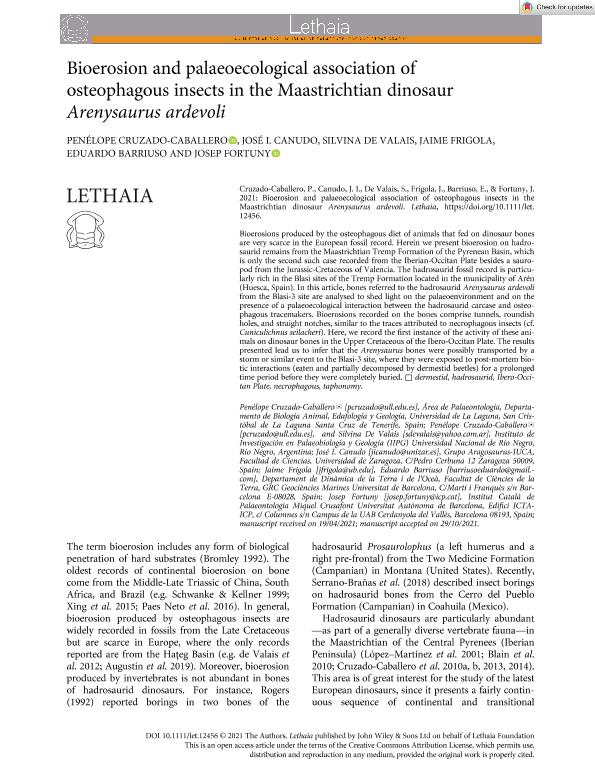Artículo
Bioerosion and palaeoecological association of osteophagous insects in the Maastrichtian dinosaur Arenysaurus ardevoli
Cruzado Caballero, Penélope ; Canudo, José I.; de Valais, Silvina
; Canudo, José I.; de Valais, Silvina ; Frigola, Jaime; Barriuso, Eduardo; Fortuny, Josep
; Frigola, Jaime; Barriuso, Eduardo; Fortuny, Josep
 ; Canudo, José I.; de Valais, Silvina
; Canudo, José I.; de Valais, Silvina ; Frigola, Jaime; Barriuso, Eduardo; Fortuny, Josep
; Frigola, Jaime; Barriuso, Eduardo; Fortuny, Josep
Fecha de publicación:
12/2021
Editorial:
Wiley Blackwell Publishing, Inc
Revista:
Lethaia
ISSN:
0024-1164
Idioma:
Inglés
Tipo de recurso:
Artículo publicado
Clasificación temática:
Resumen
Bioerosions produced by the osteophagous diet of animals that fed on dinosaur bones are very scarce in the European fossil record. Herein we present bioerosion on hadrosaurid remains from the Maastrichtian Tremp Formation of the Pyrenean Basin, which is only the second such case recorded from the Iberian-Occitan Plate besides a sauropod from the Jurassic-Cretaceous of Valencia. The hadrosaurid fossil record is particularly rich in the Blasi sites of the Tremp Formation located in the municipality of Arén (Huesca, Spain). In this article, bones referred to the hadrosaurid Arenysaurus ardevoli from the Blasi-3 site are analysed to shed light on the palaeoenvironment and on the presence of a palaeoecological interaction between the hadrosaurid carcase and osteophagous tracemakers. Bioerosions recorded on the bones comprise tunnels, roundish holes, and straight notches, similar to the traces attributed to necrophagous insects (cf. Cuniculichnus seilacheri). Here, we record the first instance of the activity of these animals on dinosaur bones in the Upper Cretaceous of the Ibero-Occitan Plate. The results presented lead us to infer that the Arenysaurus bones were possibly transported by a storm or similar event to the Blasi-3 site, where they were exposed to post-mortem biotic interactions (eaten and partially decomposed by dermestid beetles) for a prolonged time period before they were completely buried.
Palabras clave:
DERMESTID
,
HADROSAURID
,
IBERO-OCCITAN PLATE
,
NECROPHAGOUS
,
TAPHONOMY
Archivos asociados
Licencia
Identificadores
Colecciones
Articulos(IIPG)
Articulos de INSTITUTO DE INVESTIGACION EN PALEOBIOLOGIA Y GEOLOGIA
Articulos de INSTITUTO DE INVESTIGACION EN PALEOBIOLOGIA Y GEOLOGIA
Citación
Cruzado Caballero, Penélope; Canudo, José I.; de Valais, Silvina; Frigola, Jaime; Barriuso, Eduardo; et al.; Bioerosion and palaeoecological association of osteophagous insects in the Maastrichtian dinosaur Arenysaurus ardevoli; Wiley Blackwell Publishing, Inc; Lethaia; 54; 5; 12-2021; 957-968
Compartir
Altmétricas



